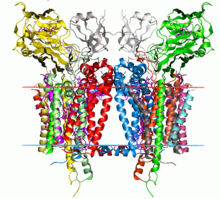| Cytochrome b6f complex | |
|---|---|
 Crystal structure of the cytochrome b6f complex from C. reinhardtii (1q90). Hydrocarbon boundaries of the lipid bilayer are shown by red and blue lines (thylakoid space side and stroma side, respectively). | |
| Identifiers | |
| Symbol | B6F |
| TCDB | 3.D.3 |
| OPM superfamily | 92 |
| OPM protein | 4pv1 |
| Membranome | 258 |
| Cytochrome b6f complex | |||||||||
|---|---|---|---|---|---|---|---|---|---|
| Identifiers | |||||||||
| EC no. | 7.1.1.6 | ||||||||
| CAS no. | 79079-13-3 | ||||||||
| Alt. names | Plastoquinol/plastocyanin reductase | ||||||||
| Databases | |||||||||
| IntEnz | IntEnz view | ||||||||
| BRENDA | BRENDA entry | ||||||||
| ExPASy | NiceZyme view | ||||||||
| KEGG | KEGG entry | ||||||||
| MetaCyc | metabolic pathway | ||||||||
| PRIAM | profile | ||||||||
| PDB structures | RCSB PDB PDBe PDBsum | ||||||||
| |||||||||
The cytochrome b6f complex (plastoquinol/plastocyanin reductase or plastoquinol/plastocyanin oxidoreductase; EC 7.1.1.6) is an enzyme found in the thylakoid membrane in chloroplasts of plants, cyanobacteria, and green algae, that catalyzes the transfer of electrons from plastoquinol to plastocyanin:
- plastoquinol + 2 oxidized plastocyanin + 2 H+ [side 1] plastoquinone + 2 reduced plastocyanin + 4 H+ [side 2].[1]
The reaction is analogous to the reaction catalyzed by cytochrome bc1 (Complex III) of the mitochondrial electron transport chain. During photosynthesis, the cytochrome b6f complex is one step along the chain that transfers electrons from Photosystem II to Photosystem I, and at the same time pumps protons into the thylakoid space, contributing to the generation of an electrochemical (energy) gradient[2] that is later used to synthesize ATP from ADP.
- ^ ExplorEnz: EC 7.1.1.6
- ^ Hasan SS, Yamashita E, Baniulis D, Cramer WA (Mar 2013). "Quinone-dependent proton transfer pathways in the photosynthetic cytochrome b6f complex". Proceedings of the National Academy of Sciences of the United States of America. 110 (11): 4297–302. doi:10.1073/pnas.1222248110. PMC 3600468. PMID 23440205.
